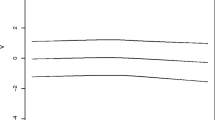Abstract
Consider the case where one obtains maximum-likelihood estimates of regression coefficients for the respective populations from which each of two large independent samples is drawn. A question sometimes asked about the results of such an analysis is whether there is a difference between a coefficient in one population, θa, and the same coefficient in another population, θb. In this paper, we evaluate the performance of two test statistics that have been used to address this problem. Our results suggest that one statistic produces valid conclusions, while the other fails.
Similar content being viewed by others
REFERENCES
Agresti, A. (1996). An Introduction to Categorical Data Analysis, Wiley, New York.
Albonetti, C. (1990). Race and the probability of pleading guilty. J. Quant. Criminol. 6: 315-334.
Allison, P. D. (1995). The impact of random predictors on comparisons of coefficients between models: Comment on Clogg, Petkova, and Haritou. Am. J. Sociol. 100: 1294-1305.
Bjerregaard, B., and Smith, C. (1993). Gender differences in gang participation, delinquency, and substance use. J. Quant. Criminol. 9: 329-355.
Clogg, C. C., Petkova, E., and Haritou, A. (1995). Statistical methods for comparing regression coefficients between models. Am. J. Sociol. 100: 1261-1293.
Cohen, A. (1983). Comparing regression coefficients across subsamples: A study of the statistical test. Sociol. Methods Res. 12: 77-94.
Cox, D. R., and Snell, E. J. (1989). Analysis of Binary Data, 2nd ed., Chapman and Hall, London.
Edwards, A. W. F. (1992). Likelihood, expanded ed., Johns Hopkins University Press, Baltimore (first published in 1972).
Eliason, S. R. (1993). Maximum Likelihood Estimation: Logic and Practice, Sage, Newbury Park, CA.
Erez, E. (1989). Gender, rehabilitation, and probation decisions. Criminology 27: 307-327.
Hagan, J. (1991). Destiny and drift: Subcultural preferences, status attainments, and the risks and rewards of youth. Am. Sociol. Rev. 56: 567-582.
Hagan, J., and Albonetti, C. (1982). Race, class and the perception of criminal injustice in America. Am. J. Sociol. 88: 329-355.
Hagan, J., and Palloni, A. (1986). “Club fed” and the sentencing of white-collar offenders before and after Watergate. Criminology 24: 603-621.
Hagan, J., and Parker, P. (1985). White-collar crime and punishment: The class structure and legal sanctioning of securities violations. Am. Sociol. Rev. 50: 302-316.
Hagan, J., Gillis, A. R., and Simpson, J. (1985). The class structure of gender and delinquency: Toward a power-control theory of common delinquent behavior. Am. J. Sociol. 90: 1151-1178.
Hagan, J., Simpson, J., and Gillis, A. R. (1987). Class in the household: A power-control theory of gender and delinquency. Am. J. Sociol. 92: 788-816.
Jaccard, J., Turrisi, R., and Wan, C. K. (1990). Interaction Effects in Multiple Regression, Sage, Newbury Park, CA.
Jang, S. J., and Krohn, M. D. (1995). Developmental patterns of sex differences in delinquency among African-American adolescents: A test of the sex-invariance hypothesis. J. Quant. Criminol. 11: 195-222.
Jarjoura, G. R. (1996). The conditional effect of social class on the dropout-delinquency relationship. J. Res. Crime Delinq. 33: 232-255.
Johnson, N. L., and Kotz, S. (1970). Continuous Univariate Distributions—I (Distributions in Statistics), Wiley, New York.
King, G. (1989). Unifying Political Methodology: The Likelihood Theory of Statistical Inference, Cambridge University Press, New York.
Kleinbaum, D. G., and Kupper, L. L. (1978). Applied Regression Analysis and Other Multivariable Methods, Duxbury Press, North Scituate, MA.
Kmenta, J. (1971). Elements of Econometrics, Macmillan, New York.
Koo, H., and Hong, D.-S. (1980). Class and income inequality in Korea. Am. Sociol. Rev. 45: 610-626.
Lindgren, B. W. (1993). Statistical Theory, 4th ed., Chapman and Hall, London.
Lindgren, B. W., McElrath, G. W., and Berry, D. A. (1978). Introduction to Probability and Statistics, 4th ed., Macmillan, New York.
Maddala, G. S. (1983). Limited-Dependent and Qualitative Variables in Econometrics, Cambridge University Press, New York.
Smith, D. A. (1984). The organizational context of legal control. Criminology 22: 19-38.
Smith, D. A., and Brame, R. (1994). On the initiation and continuation of delinquency. Criminology 32: 607-629.
Smith, D. A., and Paternoster, R. (1987). The gender gap in theories of deviance: Issues and evidence. J. Res. Crime Delinq. 24: 140-172.
Smith, D. A., and Visher, C. A. (1980). Sex and involvement in deviance/crime: A quantitative review of the empirical literature. Am. Sociol. Rev. 45: 691-701.
Spohn, C., and Horney, J. (1993). Rape law reform and the effect of victim characteristics on case processing. J. Quant. Criminol. 9: 383-409.
Visher, C. A. (1983). Gender, police arrest decisions, and notions of chivalry. Criminology 21: 5-28.
Wright, E. O. (1978). Race, class, and income inequality. Am. J. Sociol. 83: 1368-1397.
Wright, E. O. (1979). Class Structure and Income Determination, Academic Press, New York.
Wright, G. C. (1976). Linear models for evaluating conditional relationships. Am. J. Polit. Sci. 20: 349-373.
Author information
Authors and Affiliations
Rights and permissions
About this article
Cite this article
Brame, R., Paternoster, R., Mazerolle, P. et al. Testing for the Equality of Maximum-Likelihood Regression Coefficients Between Two Independent Equations. Journal of Quantitative Criminology 14, 245–261 (1998). https://doi.org/10.1023/A:1023030312801
Issue Date:
DOI: https://doi.org/10.1023/A:1023030312801




